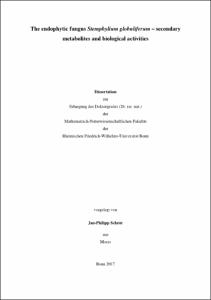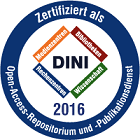The endophytic fungus Stemphylium globuliferum – secondary metabolites and biological activities

The endophytic fungus Stemphylium globuliferum – secondary metabolites and biological activities

| dc.contributor.advisor | König, Gabriele M. | |
| dc.contributor.author | Schrör, Jan-Philipp | |
| dc.date.accessioned | 2020-04-24T22:57:58Z | |
| dc.date.available | 2020-04-24T22:57:58Z | |
| dc.date.issued | 22.01.2018 | |
| dc.identifier.uri | https://hdl.handle.net/20.500.11811/7490 | |
| dc.description.abstract | Fungi are a tremendous source of pharmaceutically significant compounds, e.g. the life saving immunosuppressant drug mycophenolic acid. The current project focused on the investigation of the mold fungus Stemphylium globuliferum obtained from the marine alga Petalonia zosterifolia, with the aim to find natural products with novel chemical structures and prominent pharmacological activities, particularly antibiotic and/or anticancer effects. The fungus was cultivated on potato-dextrose-medium and found to produce strongly active antimicrobial metabolites. Subsequently, the extract was separated by vacuum liquid chromatography using a gradient elution system, as well as optimized HPLC separations. Six metabolites were obtained in pure form and characterized using spectroscopic methods. Stemphyloxin III (1) has structural similarities to the known stemphyloxins I and II, respectively, but differs concerning the moiety at C-5, where stemphyloxin III (1) has a linkage to a succinyl unit. Furthermore, the enol group at C-1 of stemphyloxin III (1) is methylated, whereas stemphyloxin I has no methylation on this functional group. Concerning the biosynthesis of 1, a polyketide origin is most likely, as proven for the structurally closely related betaenones. Compound 1 showed moderate antibacterial activities towards Arthrobacter crystallopoietes and Micrococcus luteus (agar diffusion assay, inhibition zone of 7 mm for A. crystallopoietes, 5 mm for M. luteus at 3μg, respectively). The second new compound proved to be stemphylofuran (2), a structurally most unusual metabolite consisting of a cyclic pentenone moiety connected via a methine bridge to a furan ring. Due to the presence of four quaternary carbons in the cyclopentenone the structural assignment of this part of the molecule was a challenge that could finally be solved by NOE measurements. Correlations of H-7 to H3-14 in these measurements clearly pointed towards a cyclopentenone structure instead of an alternatively assumed six membered ring. This new metabolite showed limited antibacterial activities towards A. crystallopoietes and M. luteus (agar diffusion assay, inhibition zone of 5 mm for A. crystallopoietes, 3 mm for M. luteus at 3μg, respectively). The prominent antimicrobial activity of the fungal extract could be traced back to the known metabolite stemphol (3), which showed antimicrobial effects towards methicillin-resistant Staphylococcus aureus and S. simulans with MIC values in both cases of 4 μg/ml, as well as against Candida albicans with an MIC value of 4 μg/ml. Stemphol (3) also had weak activities against the Gram-positive Enterococcus faecium and Klebsiella pneumoniae subsp. ozeanae with MIC values of 16 μg/ml and 64 μg/ml, respectively. Against Gram-negative bacteria only a weak activity was noted. From these results, stemphol (3) may be considered as an active agent against problematic Gram-positive pathogens. Furthermore, stemphol (3) was tested for its antichlamydial activity. Therefore, HEp-2 host cells were infected with Chlamydia trachomatis D/UW-3/CX. After gaining chlamydial inclusions in the host cells, the test system was incubated with serially diluted concentrations of stemphol (3). It inhibited chlamydial growth in the range of 8 to 16 μg/ml, but also had a pronounced cytotoxicity towards the host cells at high stemphol concentrations. This cytotoxic activity was investigated further using four different human cancer cell lines (Jurkat, Raji, U937 and K562 cell lines), which yielded IC50 values for stemphol of 18.7 ± 0.8 μM towards Raji cells and 22.6 ±1.2 μM towards U937 cells, respectively. Additionally the effect of stemphol (3) towards NF-κB was examined and revealed, that TNFα-induced NF-κB activity was inhibited with an IC50 of 18 μM in Jurkat cells and 30 μM in U937 cells, respectively. Overall, our results point towards a caspase-independent TNFα-induced NF-κB inhibition, making this metabolite interesting in the search for new cancer therapies. Stemphol (3) revealed limited activity against parasites, e.g. Trypanosoma brucei subsp. rhodesiense and Leishmania donovani with IC50 values of 0.18 μg/ml and 0.30 μg/ml, respectively, but again had pronounced cytotoxicity towards the control myoblast cells, showing the limited selectivity of the fungal metabolite. Radioligand binding studies revealed that 3 had weak affinity towards the cannabinoid receptors CB1 and CB2. In contrast, the resorcinol-derivative 4-butyl-3,5-dihydroxy benzoic acid (4) was not active toward CB receptors,which may be explained by the alkyl chain of stemphol (3) at C-5 instead of a carboxylic acid group at C-5 in the case of 4-butyl-3,5-dihydroxy benzoic acid (4). Furthermore, stemphol (3) showed agonistic activity (EC50 = 1.76 ± 0.27 μM) at FFAR 1 receptor, but no effects towards GPR 17, GPR 55 and GPR 84 receptors, respectively. In conclusion, this project led to the new natural products stemphyloxin III (1), stemphylofuran (2) and 4-butyl-3,5-dihydroxy benzoic acid (4) as well as the known compounds stemphol (3), infectopyrone (5) and stemphypyrone (6). Their antibacterial, antifungal, antiplasmodial and cytotoxic activities, and furthermore their affinity toward CB1, CB2 and on FFAR1 receptors, respectively, showed the broad pharmacological potential of the gained metabolites. The results of this study demonstrate that the mold fungus Stemphylium globuliferum is able to produce novel and promising lead structures for further pharmacological research and drug development based on natural products. | en |
| dc.language.iso | eng | |
| dc.rights | In Copyright | |
| dc.rights.uri | http://rightsstatements.org/vocab/InC/1.0/ | |
| dc.subject | natural product | |
| dc.subject | fungus | |
| dc.subject.ddc | 540 Chemie | |
| dc.subject.ddc | 570 Biowissenschaften, Biologie | |
| dc.subject.ddc | 610 Medizin, Gesundheit | |
| dc.title | The endophytic fungus Stemphylium globuliferum – secondary metabolites and biological activities | |
| dc.type | Dissertation oder Habilitation | |
| dc.publisher.name | Universitäts- und Landesbibliothek Bonn | |
| dc.publisher.location | Bonn | |
| dc.rights.accessRights | openAccess | |
| dc.identifier.urn | https://nbn-resolving.org/urn:nbn:de:hbz:5n-49612 | |
| ulbbn.pubtype | Erstveröffentlichung | |
| ulbbnediss.affiliation.name | Rheinische Friedrich-Wilhelms-Universität Bonn | |
| ulbbnediss.affiliation.location | Bonn | |
| ulbbnediss.thesis.level | Dissertation | |
| ulbbnediss.dissID | 4961 | |
| ulbbnediss.date.accepted | 02.11.2017 | |
| ulbbnediss.institute | Mathematisch-Naturwissenschaftliche Fakultät : Fachgruppe Pharmazie / Pharmazeutische Biologie | |
| ulbbnediss.fakultaet | Mathematisch-Naturwissenschaftliche Fakultät | |
| dc.contributor.coReferee | Knöss, Werner |
Files in this item
This item appears in the following Collection(s)
-
E-Dissertationen (4442)




